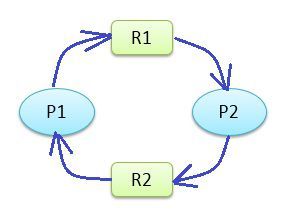


There will be the possibility of forming the circle, but it may lead to a deadlock. If there is more than one instance of a resource, it’ll not be certain in determining the deadlock. Deadlock is a paralyzing process state resulting from improper CPU scheduling, process management, and synchronization management. There is a limitation with the RAG algorithm that it’ll only work if all the resources have a single instance. Mostly, we represent vertices with a rectangular shape and edges with a circular shape: RAG has two vertices: process vertex and resource vertex, and two edges: assignment edge and request edge. Thus, we can easily avoid the deadlock.Īs every graph has vertices and edges, in the same way, RAG also has vertices and edges. We can figure out how many resources are allocated to each process and how many resources will be needed in the future. The resource allocation graph is the pictorial view of all allocated resources, available resources, and OS’s current state. The basic approaches can be combined, however, allowing us to select an optimal approach for each class of resources in a system.Using RAG, it’s possible to predict the occurrence of deadlock in an OS. In a system that selects victims for rollback primarily on the basis of cost factors, starvation may occur, and the selected process can never complete its designated task.įinally, researchers have argued that none of the basic approaches alone is appropriate for the entire spectrum of resource-allocation problems in operating systems. Where preemption is used to deal with deadlocks, three issues must be addressed: selecting a victim, rollback, and starvation. If a deadlock is detected, the system must recover either by terminating some of the deadlocked processes or by preempting resources from some of the deadlocked processes. It a system does not employ a protocol to ensure that deadlocks will never occur, then a detection-and-recovery scheme must be employed.Ī deadlock detection algorithm must be invoked to determine whether a deadlock has occurred. Operating System Concepts 8th Edition7. Using this information, we can define a deadlock-avoidance algorithm. The banker's algorithm, for example, requires a priori information about the maximum number of each resource class that may be requested by each process. To prevent deadlocks, we can ensure that at least one of the necessary conditions never holds.Ī method for avoiding deadlocks that is less stringent than the prevention algorithms requires that the operating system have a priori information on how each process will utilize system resources. The third solution is the one used by most operating systems, including UNIX and WindowsĪ deadlock can occur only if four necessary conditions hold simultaneously in the system: mutual exclusion, hold and wait, no preemption, and circular wait. Ignore the problem altogether and pretend that deadlocks never occur in the system.Allow the system to enter a deadlock state, detect it, and then recover.Use some protocol to prevent or avoid deadlocks, ensuring that the system, will never enter a deadlock state.There are three principal methods for dealing with deadlocks: Fundamental Of Computers And Programing In CĪ deadlock state occurs when two or more processes are waiting indefinitely for an event that can be caused only by one of the waiting processes.Memory-Reference Instructions - Sta, Lda And Bsa.

Operating System Operations- Dual-Mode Operation, Timer.What Is Information Systems Analysis And Design?.Types Of Documentation And Their Importance.Characteristics Of The Database Approach.
#DEADLOCK IN OS MANUAL#


 0 kommentar(er)
0 kommentar(er)
